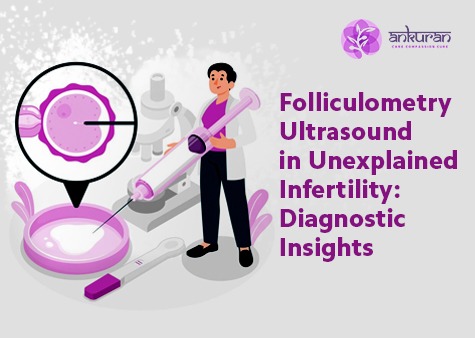Unexplained infertility can feel like a dead end. But a female fertility test named folliculometry ultrasound offers hope. This test sheds light on what might be hindering pregnancy by examining ovulation timing and egg health. So folliculometry becomes a guide, helping you and your doctor navigate the path towards parenthood.
Demystifying Folliculometry: Your Window into Ovulation
Let’s dive into your ovary’s secrets with folliculometry ultrasound, a window into your reproductive health. This test, often called a folliculometry scan, uses sound waves to track the growth of tiny sacs called follicles, each housing an immature egg. Think of it like an X-ray of your ovaries.
How folliculometry works?
A series of quick, painless scans across your menstrual cycle, usually starting around day 3, monitor these follicles. A wand-like probe inserted into your vagina sends sound waves, creating detailed images of your ovaries on a screen.
Who needs folliculometry?
While used for infertility assessment, it’s also helpful for women with irregular cycles, those undergoing fertility treatments, or those managing conditions like PCOS.
Why folliculometry is done?
Folliculometry pinpoints ovulation timing, reveals the size and number of follicles, and even detects hormone imbalances–crucial clues to understanding your fertility.
What are the benefits of folliculometry ultrasound?
This information empowers you and your doctor. It guides medication adjustments, optimises insemination timing, and identifies ovulation disorders hindering pregnancy.
Is folliculometry ultrasound safe and painless?
With no known risks or side effects, folliculometry is a comfortable way to gain valuable insights into your reproductive health. Don’t worry, the “Folliculometry test is painful” is a myth. It’s a quick and painless procedure.
Folliculometry: Unveiling the Secrets of Your Fertility
A folliculometry ultrasound (folliculometry USG) isn’t just a glimpse into your ovaries; it’s a detailed detective report on your reproductive health. But what clues does it reveal?
Interpreting the Clues:
| Dominant Follicle | A healthy follicle grows to a dominant size, indicating proper ovulation timing. Its size and timing provide insight into hormone levels and egg quality. |
| Multiple Follicles | Polycystic Ovary Syndrome (PCOS) often presents with multiple follicles, while a lack of dominant follicles may suggest hormonal imbalances. |
| Follicle Rupture | The disappearance of a dominant follicle around ovulation time means it has released its egg, a crucial step for conception. |
| Influencing Factors | Age, underlying medical conditions, and even stress can affect follicle development and interpretation. Your fertility specialist will consider these factors alongside the folliculometry USG findings to paint a complete picture of your fertility health. |
Follicle Size and Pregnancy
Have you ever wondered if the size of your follicles affects your chance of getting pregnant? It’s a common question, especially after undergoing a folliculometry ultrasound. Ideally, mature follicles reach a size of 18-22 millimetres before ovulation, offering optimal conditions for fertilization.
Size is important, But…
While optimal follicle size plays a role, it’s not the sole determinant of pregnancy success. Age, egg quality, hormonal balance, and sperm health are all crucial players in the grand orchestra of conception.
Can Folliculometry Predict Pregnancy?
While folliculometry plays a vital role in fertility assessment and treatment planning, it cannot directly confirm pregnancy. That’s because a mature follicle simply indicates ovulation potential, not successful fertilization or implantation.
For pregnancy confirmation, additional tests like a home pregnancy test or a blood hCG test are essential. Remember, folliculometry is a powerful tool, but it’s just one piece of the puzzle.
By understanding the insights folliculometry offers, you and your fertility specialist can work together to navigate your fertility journey with greater clarity and confidence. It’s a valuable step towards unlocking the beautiful possibilities of parenthood.
Decoding Your Folliculometry Report
A Normal folliculometry report indicates healthy follicle development throughout your cycle. We’ll break down the main points of the report here. It typically includes key components like:
| Dominant Follicle Size | This star follicle reaches ideal maturity (around 18-22mm) before ovulation, suggesting good egg quality. |
| Endometrial Thickness | The lining of your uterus, crucial for embryo implantation, shows optimal growth. |
| Ovulation Timing | Confirmation of ovulation based on follicle disappearance or a shift in its characteristics. |
| Additional Notes | Any other observations noted by your fertility specialist during the folliculometry test procedure. |
While numbers and terms might seem overwhelming, remember that your fertility specialist will guide you through the report, explaining its details and what they mean for your specific situation.
Bottom Line
Unexplained infertility can feel like a maze, but folliculometry ultrasound offers a guiding light. We’ve explored how this test decodes fertility secrets, from optimal follicle size to interpreting your unique report. The folliculometry test price might seem like an expense, but consider it an investment in valuable information. It can guide treatment decisions, optimize timing for conception, and ultimately, bring you closer to your dream of parenthood.
Remember, knowledge is power. Embrace clear communication with your fertility specialist, and unlock the doors to parenthood. That’s why Ankuran Clinic is your best option. It is renowned for its expertise and compassion, to navigate your fertility journey with confidence. At Ankuran Clinic we offer state-of-the-art facilities and a dedicated team best IVF Doctors in Kolkata are committed to guiding you every step of the way.



No Comments